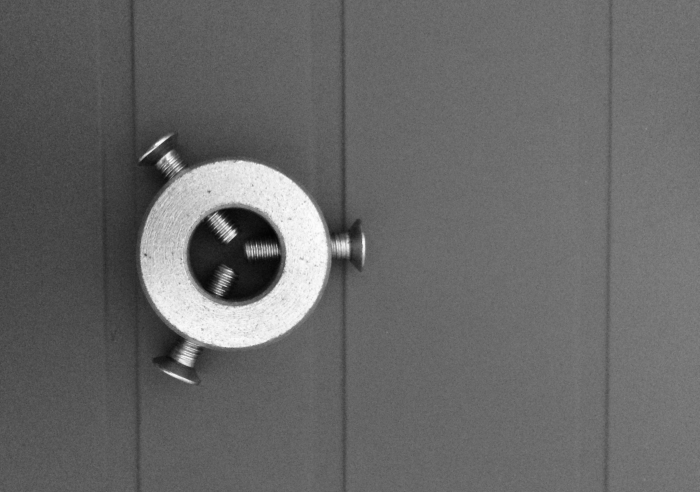
It is pretty amazing how much you’re willing to figure out a math problem when it goes beyond the SAT tests or a high school exam. A few weeks ago, when we were trying to resolve the connections for the 27 steps pyramids, we came across a beautiful connection detail on a scrap tri-pod-like piece.

27 steps (connection)
(image: Anesta Iwan + Nish Kothari)
A metal ring, drilled at three points (equally spaced along the circle, 120/120/120) connects three metal rods together via simple screws. Each rod can then rotate tangentially to the ring at its respective contact points. We stood there for a while trying to gauge whether or not it would be possible to produce our desired angles of the pavilion (45/45/60). At first we were not convinced, but something about the number three and the rotations convinced me that it was going to work – I thought, “there are three possible degrees of rotation, and I have three rods that rotate, so it MUST work!”

Breakfast at Tiffany’s
“Do you have anything for ten dollars?”
Of course I was just desperate and ended up piecing together my own rationale to confirm my “logic.” However it was enough to convince us then. We ended up buying the ring for just one dollar! (and scrapped the rods that were attached to it). It was such a simple connection – we had to make it work.
 27 Steps (straw model)
27 Steps (straw model)
(image: Anesta Iwan + Nish Kothari)
After doubting it all through the ride home, I built a small mock up out of straws and a few bent paperclips that demonstrated similar tectonics. It seemed to work. But even then I was not 100 percent convinced. It was small and with straws and clips, there’s definitely a larger tolerance than when we build in metal.
 The Starry Messenger
The Starry Messenger
Galileo Galilei
So I looked to Galileo for inspiration –
“The universe cannot be read until we have learned the language and become familiar with the characters in which it is written. It is written in mathematical language, and the letters are triangles, circles and other geometrical figures, without which means it is humanly impossible to comprehend a single word.”
– Galileo Galilei, Opere Il Saggiatore[1]
Can I use math to solve this? I began to sketch the limitations of the rods and the domain in which they are able to intersect. It’s a bit like an extrapolation where the hinge point is at the screw and rods are the extended unknown set of data. The rules are there and they are simple – three rods rotate tangentially around a circle of a given radius. And through the basic Pythagorean geometry, I also know that the angles between the rods are 45, 45, and 60 degrees. However, because of the ring, the rods will not come together at point, so the angles will differ from 45, 45, and 60 ever so slightly depending upon the diameter of the ring. But up till now, these are my initial hypotheses; I still need to prove it as being true or false.
27 Steps – galapagos for connection
(video: Anesta Iwan + Nish Kothari)
After a few more sketches, it was clear that I needed something smarter that can calculate this for me. Through a simple Galapagos script in Grasshopper, the algorithm was able to generate the closest solution that rotated each of the three rods so to achieve as close to 45, 45, and 60 as possible. In the end, the results yielded a difference of only 0.03 to 1.01 degrees in all three angles. And so I conclude: yes the connection piece will be able to produce the angles we needed for the frame connections.
We learn to observe for questionable opportunities just as Galileo first observed the specs traveling around Jupiter.[2] We experiment and test with models as Galileo built greater and greater telescopes to help him understand the world beyond. Though solving the math was the goal in this process, it’s only a sub-goal to making 27 steps happen.

27 Steps
(image: Anesta Iwan + Nish Kothari)
.
[1] http://www.gogeometry.com/math_geometry_quotes/galileo_math.html